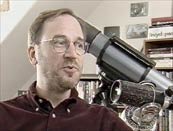We had black holes in the original series, but by Next Generation we�d got a wormhole. How are they different?
 Black holes were conceived probably as early as the 1920s, possibly even before that. There was even some discussion I think that Immanuel Kant mentioned that one could imagine a star so massive its surface gravity would be high enough so that the escape velocity from the surface of the star would be greater than the speed of light. Because light could never escape it, we would never be able to see it.
Black holes were conceived probably as early as the 1920s, possibly even before that. There was even some discussion I think that Immanuel Kant mentioned that one could imagine a star so massive its surface gravity would be high enough so that the escape velocity from the surface of the star would be greater than the speed of light. Because light could never escape it, we would never be able to see it.
Such a star would not be stable, but after Einstein developed his general theory of relativity, physicists began to realise that you could compress matter to an extraordinary degree. You could create something called a singularity which is essentially a point of infinite density that could have the mass of several stars and the gravity from that object would be so great that light could not escape it. And that became known as a black hole and that�s the term that�s typically used in in the astrophysics literature today.
They were also called black stars in the 1940s and �50s and that�s the term that was used in the original series. In an episode called Tomorrow is Yesterday when the Enterprise encountered a black star and it was through gravitational slingshot effect, shot back toward the Earth, but also back in time. That was either very prescient of the writers, or just kind of a lucky guess where someone might have looked at the literature and seen that black holes could actually, in some circumstances, be used as time machines.
I�m not sure what extent that scientists appreciated that in the 1960s, but that�s been well established today. Wormholes were also something that Albert Einstein and a couple of colleagues realised could possibly exist in our universe in the mid-1930s. That didn�t get out into the popular literature until much later when they were called Einstein-Rosen bridges.
In the 1950s a physicist named John Wheeler coined the term wormhole because it�s somewhat analogous to a worm eating his way through an apple. Instead of taking the long way round, the worm actually takes a short cut from one side of the apple to the other by eating his way through. In Einstein's theory of relativity he seems to suggest that space might be warped to such a degree that there could be these sort of higher dimensional shortcuts to make it possible to travel great distances in very, very short periods of time.
